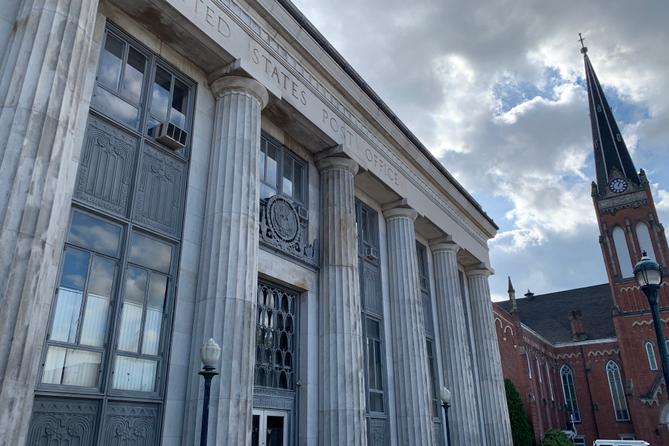NEW CASTLE — The cracked glass doors of the vacant post office building reflect back the historic town center. Behind the padlocks, a dusty staircase strewn with crumbled plaster leads to an empty foyer.
Across the town center, known by locals as “the Diamond” for its shape, another former anchor of downtown is dark. Once the headquarters of utility company Penn Power, part of the cavernous ground floor now houses the city’s Christmas decorations. Wreaths of green tinsel stacked against the windows flash in the sunlight.
Bill Mitsos, 55, is the co-owner of the M&P Coney Island hot dog restaurant, which is one door down from the Penn Power building. He said he remembers when the family business, founded in 1923, attracted a crowd every day for lunch. Now, almost all of their sales come from another location in the suburbs.
“It’s one of the few places left downtown and we’ve kept it open on purpose,” Mitsos said.
A federal tax incentive program passed in 2017 by Republicans in Congress has been hailed by President Trump as a lifeline for ailing Rust Belt cities like New Castle, where residents share an all-too-familiar struggle despite the rebound of the U.S. economy.
The central premise of the program is simple: offer wealthy investors generous tax breaks for putting money into real estate or businesses in distressed areas. Those areas were designated “opportunity zones.”
In Pennsylvania, however, early signs suggest the program is not living up to the claims of transformative change, and is unlikely to be a cure for the communities most in need of a boost. Instead, investors appear to mostly prefer areas already experiencing redevelopment, where the payday will be far greater.
“It wouldn’t surprise me if the vast majority of investment went to a handful of zones in central cities that are already exploding with growth,” said Adam Looney, a senior fellow at the Brookings Institute, who has studied the program.
And the areas desperate for redevelopment? “Investors will mostly skip over those places," Looney said.
» SEND A TIP: Spotlight PA is following the money flowing through Pa.’s many economic development and grant programs. If you know of an investigation we should pursue, securely send us a tip.
There’s still plenty of time to take advantage of the program, and a lack of public reporting requirements makes it difficult to track exactly where the money is going. There are also clear success stories, like a business incubator planned near Scranton, an old warehouse being converted into apartments in Bethlehem, and a start-up company moving from suburban Chester County into the city of Coatesville.
Perhaps the most organized effort around the program has been in Erie, where local leaders said they have already secured roughly $13 million in new investment. The chamber of commerce has dedicated a full-time employee to the effort, and the city has aggressively marketed its zones, highlighted by a two-day “homecoming” event in August, when attendees toured potential development sites.
The keynote speaker was Housing and Urban Development Secretary Ben Carson, underscoring the politics inextricably linked with the program. The president touts the tax incentive as an example of how he has improved the lives of black residents in urban areas. But it’s unclear how much opportunity zone investments will directly affect the lives of residents in these communities, and, unlike some other economic incentive programs, there’s no requirement that projects show a clear public benefit.
» READ MORE: An in-depth look from our partners at PA Post at how Erie is trying to use the tax incentive to help turn around its decline.
Most other areas designated as opportunity zones in Pennsylvania are far less organized than Erie, and some lack the resources to mount even a modest marketing campaign.
“We just haven’t had the capacity to move forward with it,” said Sara Andrews, executive director of the Office of Economic and Community Development in Bradford, in northwestern Pennsylvania. “It’s very difficult for small communities.”
In Warren — one county over, on the edge of the Allegheny National Forest — “getting the designation was easier than trying to make use of it,” city manager Nancy Freenock said.
Jennifer Wakeman, executive director of DRIVE, an economic development agency serving Columbia and Montour counties, said there was no clear answer.
“I don’t know how we make our rural area compete,” Wakeman said.
The primary benefit of investing in opportunity zones is that, after 10 years, any profits, or capital gains, are free from federal taxes. For real estate investors looking to maximize their returns, the most appealing deals are in places where property values are likely to soar over the next decade, yielding a tax-free windfall.
But in order to make money, you need to have money. Investors must already have earned capital gains — profits from selling stock or other investments. Only an estimated 8.6 percent of U.S. taxpayers paid capital gains tax in 2018, according to the Tax Policy Center, a Washington, D.C. think tank.
Those capital gains must be put into special funds dedicated to opportunity zones. Many of those funds have minimum investments starting at $100,000, or are open only to accredited investors — people who consistently earn more than $200,000 a year.
With more than 8,700 opportunity zones across the U.S., including 300 in Pennsylvania, investors that do make the cut have plenty of options, including fast-growing census tracts in Philadelphia that would likely see continued investment even without the tax breaks.
“Unsurprisingly, Philadelphia has been receiving the most attention so far nationally, but a lot of other smaller cities in Pennsylvania are just as viable,” said Evan Weiss, an opportunity zone policy expert who works as an advisor for New Jersey Gov. Phil Murphy.
At the intersection of Jefferson Ave. and 31st St., in Philadelphia’s Brewerytown neighborhood, investment from an opportunity fund is helping to finance the conversion of a towering, redbrick former brewery into luxury loft apartments that will rent for between $1,000 and $2,200 a month. Once completed, the brewery will be the latest addition to a street already lined with new and modernized apartment buildings.
Developer David Waxman, whose company has been working in the neighborhood for years, said the project was planned before the opportunity zone incentives became law — and would have gone ahead without them. Now, however, some investors stand to earn far greater profits.
Waxman said development spreads outwards from thriving areas and, as time goes on, money may flow to the city’s less desirable zones, too. “You can’t just plop something down in the middle of an area that hasn’t seen investment,” he said.
Gov. Wolf had the final say over which eligible census tracts became opportunity zones, but largely followed the recommendations of local leaders. Officials at the city planning department said they tried to balance areas that were already growing with ones that had been starved of investment. Choosing only the most distressed neighborhoods, they said, would risk dampening investors’ interest.
But choosing fast-growing areas like Brewerytown could also risk accelerating gentrification. A study by the Urban Institute, a Washington D.C.-based think tank, found that almost a fifth of the city’s opportunity zones were already showing signs of “rapid socioeconomic change” before they were chosen for the program.
Pittsburgh took a much different approach. Citing the risk that opportunity zone investments could cause “speculative pressure in vulnerable real estate markets” because of a lack of regulation, city officials recommended areas with little ongoing development activity.
“Mayor Peduto is hopeful that if opportunity zones are implemented in Pittsburgh they would be tailored to neighborhoods that have not seen high levels of investment,” Timothy McNulty, the mayor’s spokesperson, said in a statement. “But that’s a big if — he remains cautious about the Trump administration implementing plans that truly benefit all.”
In presentations to local leaders, state officials have made clear the opportunity zone incentives aren’t powerful enough to make people invest where they otherwise wouldn’t.
The incentive, “doesn’t make bad deals good. It’s only going to make good deals better,” said Scott Deitrich, the state’s point person for opportunity zones, during a presentation in June. “If investment is not occurring in real estate markets within your community already, it’s not likely that this incentive will spur that investment.”
And so, despite the lofty claims around the program, it’s unclear where it leaves communities like Clairton, a small city in Allegheny County still struggling to recover from the collapse of the steel industry.
At Clairton Hardware — “industrial supplies since 1934” — the store is closed but the sign remains, red paint flaking to grey. Down the street, past several grassy vacant lots, “Jus Us In The Pink” has a “for rent” sign in the window next to leftover merchandise and decorations: a pink vase, a bundle of artificial blue hyacinths, a pair of white china dogs.
Cheryl Hurt, 72, said her mother opened the store in the late 1980s. Now, the building has problems with the roof and Hurt has fallen behind on the property taxes.
“I’d almost be willing to give it away,” said Hurt, who runs a daycare a few blocks away. “It’s a nice place, it just needs some money put into it.”
Mayor Richard Lattanzi knows the things residents want — like a bank, more small shops and a grocery store — are not the most lucrative or enticing for investors. Aside from a Speedway gas station and convenience store built in 2017, “we haven’t seen any development here in years,” Lattanzi said.
A consulting firm has created a map of opportunity zones, color-coded according to their “baseline economic fundamentals” — or, put another way, places poised for growth that could turn a profit for investors. The most attractive areas are dark blue. Clairton, at the other end of the spectrum, is a cluster of orange and dark red.
Spotlight PA receives funding from nonprofit institutions and readers like you who are committed to investigative journalism that gets results. Become a Founding Donor today at spotlightpa.org.

